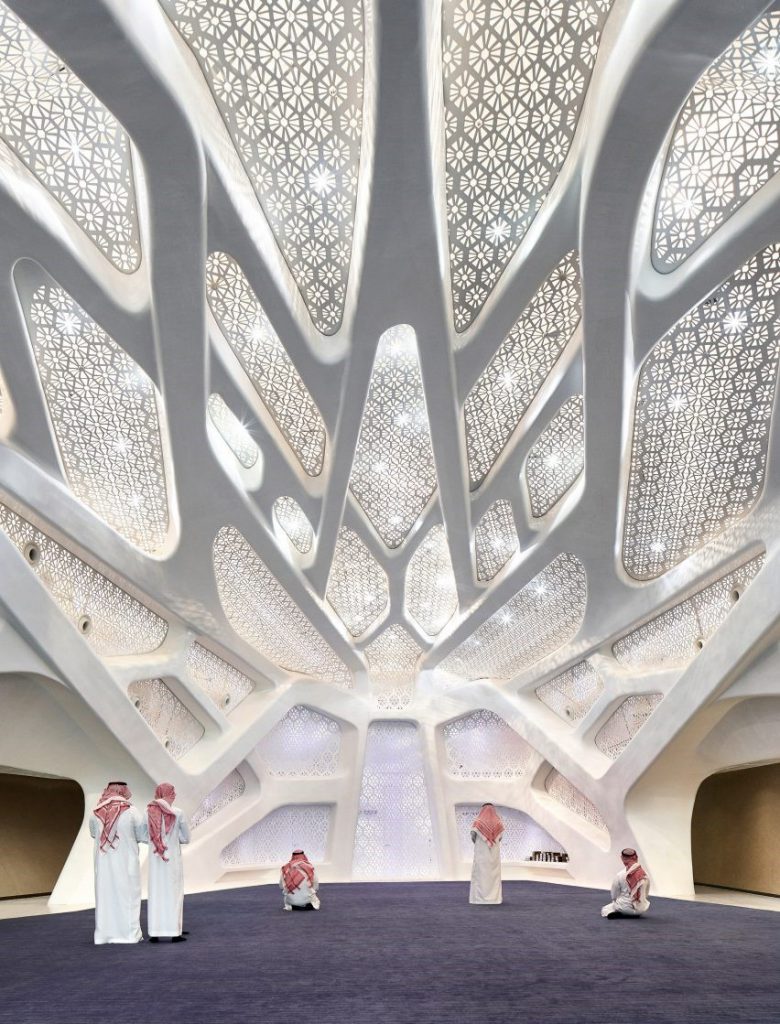Written by NDA tutor Amy Payler-Carpenter
Architecture and Interior Design can evoke feelings of calm and solace within its occupants, sometimes this is due to a personal connection to a place, and other times this is the intent of the designer or architect. Religious spaces are created with spiritual purpose and intent, this allows the visitor a moment of peace and quiet reflection. Sacred architecture is one of our earliest forms of spatial design, from Egyptian Temples to the great Basilica’s of the Renaissance. But how has this developed and is it still relevant in contemporary architecture and design?
 The Pantheon, Rome.
The Pantheon, Rome.
Possibly the most recognisable of all religious spaces has to be the Pantheon, the former Roman temple completed in 125 AD. Its name comes from the term to “honour all Gods” and was built as a space for people to do just that. Upon entering the building, you will be struck by the 43.2-metre-high dome, which is as wide as it is high, creating a perfect semi-sphere. At the very top of the dome is an opening, almost 9m wide which opens up into the sky. This is sacred architecture at its most impressive, built with status and celebration in mind.

Smaller in scale, but no less impressive is the Mosque-Cathedral of Cordoba in Spain, which has been used for Islamic, Catholic and Christian worship since it was founded in the 6th Century. It is misleading to say smaller in scale, as the site as a whole cover 800,000sqm, but this is broken down into smaller spaces, each dedicated to a different religion or saint. The image above has been taken from the Mihrab, which is a space indicating the direction of Mecca. Here this is located within the Maqsurah, a structure which traditionally would be used to hide a ruler from assassination. This space is opulent, and the walls are covered in inscriptions which allude to its creator. This form of architecture reflects status and safety to those who are wealthy enough to afford it.

Now to a slightly more modern interpretation of traditional sacred design; The Temple of All Religions has been under construction since 1992. It has been described as ‘Frankenstein’s Chapel’ as it houses spaces for and shows influences from almost all major faiths. The building is colourful, both inside and out. The aim of this space is not primarily as a place for worship, instead, this was designed as a symbol of religious unity by philanthropist Ildar Khanov. It differs from the examples we have looked at so far as this is more about creating a sense of community than a space for worship.

With an aim to boost the numbers of people visiting religious places, some are creating cultural experiences with an aim to entice a wider audience. The above intervention was installed into the Nave of Canterbury Cathedral in May 2018 to commemorate the 100th anniversary of the First World War. A 100 glass amphorae, vases based on a traditional Roman design, hung from the roof, one for each year which had passed since 1918. The installation was part of a larger one spread throughout the Cathedral, designed by artists Baldwin & Guggisberg. This illustrates how religious spaces can adapt to a modern audience.

So how do you design a contemporary religious space whilst still maintaining the spiritually inclusive atmosphere illustrated by the examples above? The Bishop Edward King Chapel in Oxford designed by Niall McLaughlin Architects in 2009, combined two concepts, the first being a ‘gentle hollow in the ground’ and the second a ‘delicate ship’ which ‘rises into the treetop’. The concept started with the word ‘nave’ which describes the central part of a church, derived from the Latin word Navis, meaning ship. It is the marriage of these two concepts which have created a sense of calm, and that quiet contemplation many crave in modern society.

You may have experience of visiting a prayer room or chapel in a public building, but not many of us will have had the luxury of visiting one designed by world-renowned firms such as Zaha Hadid Architects. The Musalle Prayer Space at the KAPSARC, completed 2017, is based on a modular honeycomb formation, to reflect the company’s aim of moving towards a more sustainable power source. This space truly embodies the concept, with the function becoming secondary.

The idea of minimalism and a chapel may not naturally go hand in hand, however, that is exactly the combination used by Site Specific Arquitectura, the Portuguese firm, when asked to add a small extension to a former warehouse, which would be used for prayer, communication and assembly. The existing building may also seem unconventional for the work of a brotherhood activity involved within the community. However, what this style of architecture shows us is that by being recognisable and of the ‘norm’ it may be less intimidating than the conventional monastery setting, therefore have the ability to reach a wider audience. The simplicity of the design, completed in 2015, reflects the austere philosophy of the brotherhood and like many other religious spaces uses natural resources, such as light.

The prayer hall shown above is the central meeting place at this Mosque in Singapore. The Architects took inspiration from Islamic art; pictures of people are forbidden in holy places, therefore techniques developed which helped artists create geometric patterns that could be used to decorate these spaces. This geometric inspiration can be seen throughout the building but is most prominently in the ceiling of the prayer hall. This allows light in and creates a lattice effect across the floor, much like the prayer hall within the KAPSARC. The intrinsically moulded ceiling and light shafts it creates is the only feature of the room bar the simple curved bench which wraps itself around the hall, leaving the occupant free from external distractions.

Spaces might not be specifically built for the purposes of religion, sometimes the space comes before the function and just encapsulate spirituality, so what can we learn from these spaces? Between the two separate parts of the Salk Institute in San Diego sits a channel leading the eye to the horizon. This was initially designed to house a small garden; however, Khan was convinced by a fellow architect to instead fill the void with water. This intervention, central to the site is purposely placed to make visitor pause, offering a moment of reflection.

Carlo Scarpa was asked to design an extension to the existing cemetery at San Vito D’Altivole when Giuseppe Brion, a prominent local businessman, died in 1968. The aim here was to create space to house Brion’s tomb, but to also offer a place of remembrance, not only for family but for those who admired him as a public figure. It needed to be a place for contemplation and used simple forms, natural light and water to achieve this. Although neither this nor the example above are religious spaces, the same techniques are used to create somewhere in which an occupant can take time out.
Reflection can take place anywhere, however, there are a few key ideals shared by the projects which have been focused on here. The first is the idea of scale, the majority here use this, in particular height, to impress and impose, creating a connection to the heavens. A strong concept it key, whether this be reflective of the religion, location or function. Natural resources are also something which are utilised often in religious spaces, namely light and water. Nature is proven to have a calming effect on the body and this in turn would aid prayer or meditation. Traditionally this style of architecture was opulent, however contemporary design has moved away from this using simpler forms and materials, so as not to over stimulate the visitor. What is apparent from the research carried out here is that religious spaces are becoming more inclusive, with an aim to bring a variety of people and religions together. These spaces are also reaching out to those who do not identify as religious, offering places in which a whole community can come together and socialise. Ultimately reflection can take place anywhere, this is somewhat subjective, with each person needing something different from a sacred place. Therefore, is it the job of the designer, architect or organisation to entice visitors, offer an experience and a sense of community.

